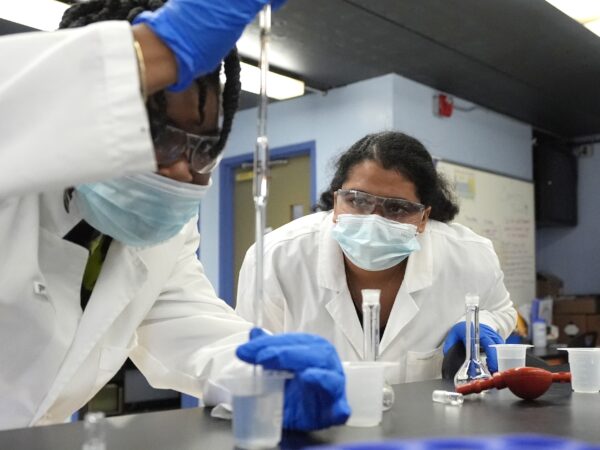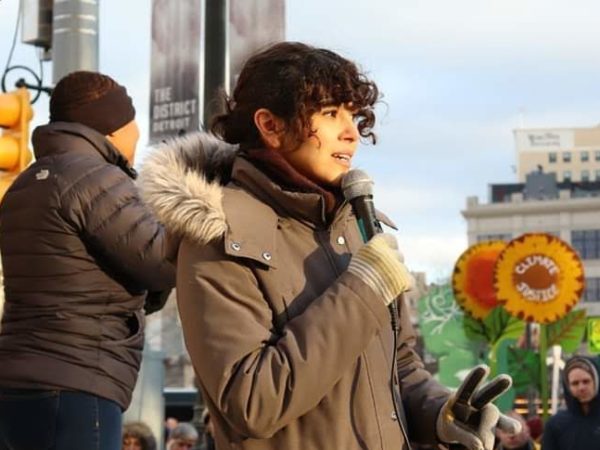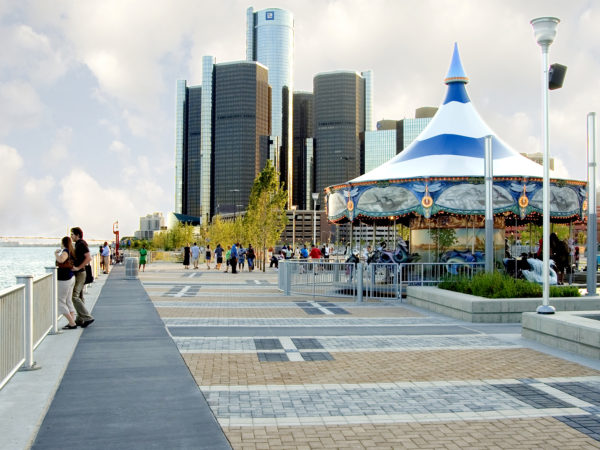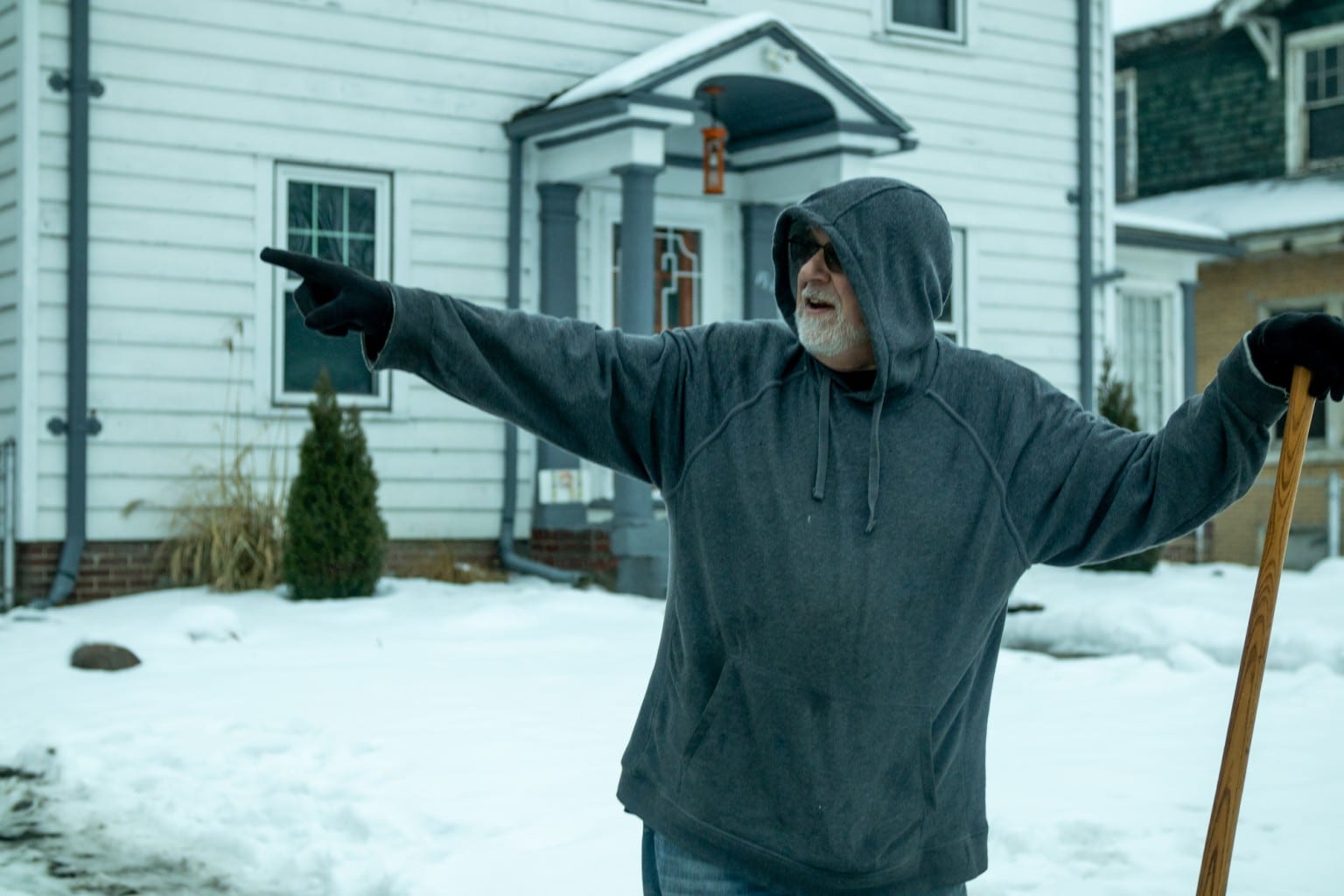
This article was republished here with permission from Planet Detroit.
By Brian Allnutt, Planet Detroit
Neighborhoods east of Palmer Park could soon be transformed by a city plan to power municipal buildings with six solar fields, and neighbors are divided over the prospect.
Depending on who you ask, three projects for 140 acres of solar around the Chaldean Town, Greenfield Park, Grixdale Farms and State Fair neighborhoods are viewed as a major opportunity for residents or a risky undertaking that could drive disinvestment.
Residents have until Jan. 31 to sign a form indicating whether they approve of the projects that will be implemented in six city neighborhoods.
John Gruchala, who lives on Parkhurst near the proposed Greenfield Park solar project, has been in the neighborhood for fifty years and thinks solar developments could hurt efforts to attract more residents.
“This is the center of the metropolitan area, and you’re taking such valuable land,” he said of the neighborhood, which is within 15 minutes of downtown Detroit and Birmingham and close to expressways.
Brenda Price, who lives on Hildale Street near the Grixdale project site, supports the plan, saying it will reduce blight and offer a rare opportunity for residents to sell their homes.
“You can go in any direction in Detroit and find a neighborhood that looks like that, or blocks that look like that,” she said of the largely abandoned area in the solar field’s footprint. “The expectation that it’s going to change is not likely.”
The initiative, announced in June, could have profound consequences for the neighborhoods and the finances of those within its footprint if implemented.
After a series of community meetings, the city selected nine neighborhoods to consider for solar arrays, which will be narrowed to six, to assemble the 250 acres needed to power city buildings. Detroit Mayor Mike Duggan has pitched the program as a way to fight climate change and cut down on illegal dumping by fencing off abandoned areas.
Differing visions for what the solar plan will mean for residents led to a heated debate over the Grixdale Farms project at last week’s meeting at the American Community Council Youth Center on East Seven Mile, where more than 30 residents often shouted to be heard.
Some said the deal was too good to pass up for an area that has seen so much disinvestment, while others said large solar farms could hurt home values and kill future development. Some felt they didn’t have enough information to make an informed decision.
Outcomes for residents will depend on how houses are valued in a future buy-out, the amount of community benefits proposed for each homeowner and the effect solar fields will have on neighboring property values.
Homeowners in the footprints of the proposed solar fields stand to receive twice the fair market value of their homes or $90,000, whichever is higher, while renters will get 18 months of rent to relocate. Homeowners within community benefits areas surrounding the projects will receive $15,000 to $25,000 each for energy efficiency upgrades.
A city spokesperson previously told Planet Detroit the city is seeking federal credits to offset municipal operations’ energy use under the Inflation Reduction Act. It will choose the six neighborhoods that end up with solar panels based on which areas receive the most support.
“The decision of which areas are selected for solar arrays will be determined by which of the finalist neighborhoods demonstrate the highest level of support compared to the others,” Erinn Harris, deputy director of the Department of Neighborhoods, told Planet Detroit.
City council will vote on whether to approve the plan once the city selects the six final project proposals.
Property values, crime and city control
Kevin Bingham, who lives on Greendale St. in the Grixdale project’s community benefits area, said large solar projects would be unattractive and is concerned they could hurt property values.
A recent study on solar fields in California, Connecticut, New Jersey, Minnesota, and Massachusetts found properties within half a mile had values drop by 1.5%, although outcomes varied by state.
Bingham worries that the plans signal the city is abandoning the neighborhood.
“If you’re going to do a solar farm, there’s absolutely no reason to redo Seven Mile with businesses,” he said. He’s also concerned about what removing residents could mean for schools and businesses.
Bingham, an arborist, would lose two lots on Robinwood Street and one on Goldengate that he purchased to protect large oak trees that he says are several hundred years old. He expressed concern about removing tree cover, which helps mitigate against the urban heat island effect and flooding.
Although climate experts say solar power is crucial for dealing with the climate crisis, research shows solar arrays can create a localized increase in temperature. This may be a problem in Detroit, where the heat island effect, or the capacity of hard surfaces to absorb and re-emit heat, can amplify temperatures by 8 degrees or more.
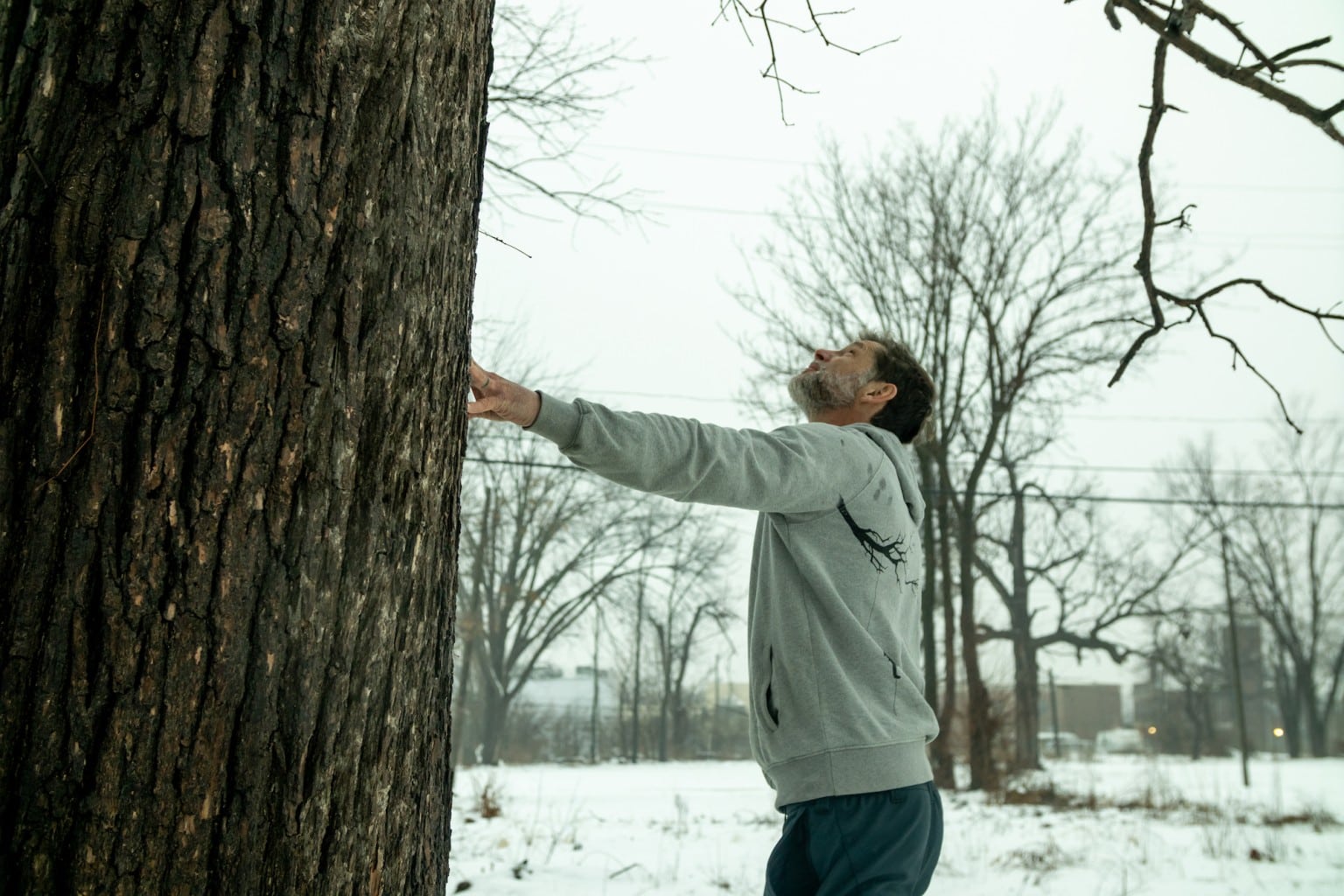
Kevin Bingham examines an old oak tree on his property within a proposed solar zone in Grixdale Park. Photo by Quinn Banks.
Asher Van Sickle, a Hildale resident who owns two area rental properties, said he isn’t against the Grixdale project and appreciates the potential financial benefits for homeowners and renters. But he’d like to know more about the city’s commitment to fencing and beautifying the perimeters, fearing the neighborhood could wind up with an “eight-foot chain link fence with barbed wire.”
The project’s Request for Proposals says that “fencing will be set back 20’ from a property line that borders a right-of-way used by the public, and the setback shall be maintained with landscaping.”
Van Sickle said fenced off-solar fields aren’t a magic bullet for dealing with crime on abandoned blocks, believing it could just move into more heavily occupied areas to the south.
“Displacement does not solve crime,” he said.
However, Duggan spokesperson John Roach disagreed.
“When an area that has been an attractive nuisance for crime is put back to productive use, it ultimately is a deterrent to crime by disrupting it, ” he said.
Van Sickle said city ownership might also mean Detroit could pursue future development with little input from residents.
“We want a seat at the table in how this project … is going to be carried out,” he said. “And a secured seat at the table for future development.”
Roach said the final designs will be decided in collaboration with residents in each neighborhood.
A ‘life-changing’ opportunity
Diane Davis, a 38-year resident who lives on Hildale, expressed her support for the project at last week’s meeting. She compared it to a job where “you do what you need to do until you find something better.”
She told Planet Detroit that although the home repair money from the project might not go very far for her, the solar project represented a low-risk opportunity that could reduce blight.
Price said replacing abandoned structures with a fenced-off solar field would remove opportunities for dumping and criminal activity.
“There’s no place to commit a crime if there’s no shelter for anybody,” she said.
She added that the money provided to homeowners and renters would be “life-changing,” giving them an option she didn’t think they would get otherwise and potentially opening up other opportunities.
“Eighteen months free rent, that gives somebody who’s low-income an opportunity to save money to buy a house, put a kid through college for a year or two,” Price said.
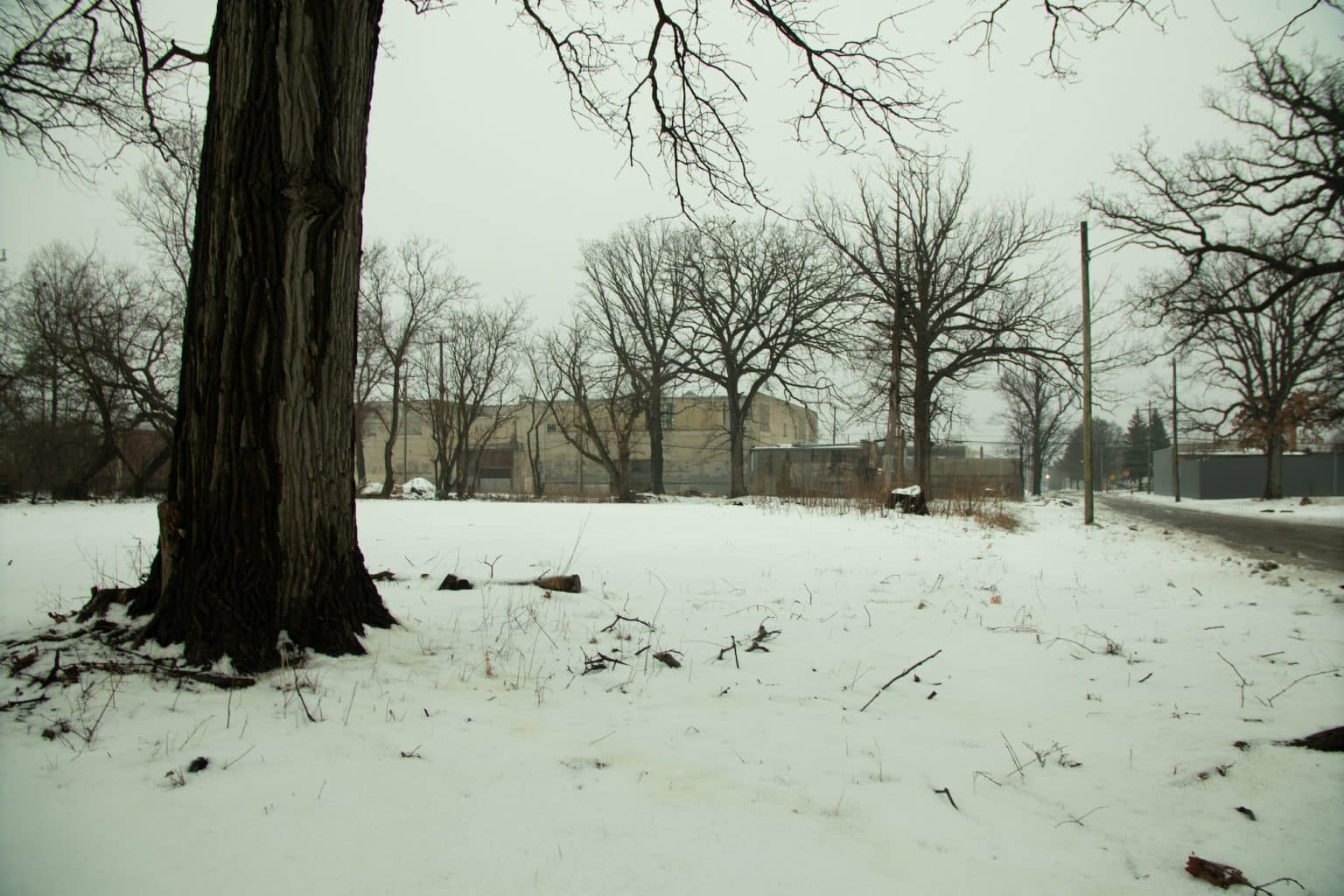
An empty lot in the Grixdale neighborhood on Robinwood west of John R is potentially slated for a solar farm. Photo by Quinn Banks.
Transparency and outreach are sticking points for some
Several residents told Planet Detroit they didn’t know enough about the project to make a decision. Dominique Kada, a lifelong resident on Hildale, said she could see both positive and negative outcomes.
“I just heard about it last week from my mom, and she heard by word of mouth,” she said.
John White, who lives on Parkhurst near one of two proposed solar fields in the Greenfield Park area, opposes the plan. He said solar is an industrial use that would change the neighborhood’s fabric. But his biggest issue was with how the project has taken shape.
“I’m opposed to the way they’re pushing it and the (lack of) transparency of this whole thing,” he said.
White questioned why the city kept having meetings after he showed up at two sparsely attended meetings where residents said they weren’t interested in solar fields. He said this undermined the mayor’s statement that the city would only develop projects in areas where they were wanted.
He pointed to a flier for a meeting in the fall that mentioned $250,000 in possible community benefits without mentioning solar, with the dollar amount referring to the total benefits for a 10-acre solar field. Gruchala had a similar flier from August that also failed to mention solar.
White questioned how residents could be expected to help select areas for solar projects when they weren’t even told what the meeting was about.
Harris, from the Department of Neighborhoods, said, “The Greenfield application was submitted by a group of neighbors in the area, and the applicants have demonstrated broad community support.” She declined to share a copy of the application.
Harris added that outreach has been ongoing since last summer and groups of neighbors have been going door-to-door to talk to residents. She said the city is going to every house in the solar project areas to collect signatures for and against the proposed projects.
Gruchala expressed frustration that the city was expending so much energy on the solar plan, noting that simple fixes like adding bus stops or a crosswalk connecting his neighborhood to Palmer Park could make the area more attractive to newcomers.
“They’re basically saying, ‘Well, it’s just a blighted, destroyed area,’” he said.
Correction: A previous version of this article said the city was seeking federal funding under the Inflation Reduction Act. The city is seeking IRA credits to offset municipal operations’ energy use.
Catch more news at Great Lakes Now:
‘It only makes sense’: Houses of worship adding solar arrays
Waves of Change: Meet Wisconsin Green Muslims founder and director Huda Alkaff
Featured image: John Gruchala shovels snow on Parkhurst St, near the proposed Greenfield Park solar project. Photo by Quinn Banks.


